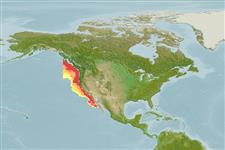Environment: milieu / climate zone / depth range / distribution range
Ecología
marino batipelágico; rango de profundidad 450 - ? m (Ref. 82347), usually 699 - ? m (Ref. 58018). Deep-water; 55°N - 25°N, 134°W - 112°W
Northeast Pacific: Queen Charlotte Islands in British Columbia, Canada to central Mexico. Records from Alaska are erroneous (Ref. 11458).
Tamaño / Peso / Age
Maturity: Lm ? range ? - ? cm
Max length : 30.4 cm TL macho / no sexado; (Ref. 41039)
Short description
Morfología | Morfometría
Espinas dorsales (total): 0; Radios blandos dorsales (total): 84-88; Espinas anales 0; Radios blandos anales: 69 - 75. Variable in color, black on head and abdomen, brownish elsewhere (Ref. 6885). Living color sometimes silvery blue (Ref. 6885).
Occurs in deep coastal waters (Ref. 2850).
Life cycle and mating behavior
Madurez | Reproducción | Puesta | Huevos | Fecundidad | Larva
Anderson, M.E., 1994. Systematics and osteology of the Zoarcidae (Teleostei: Perciformes). Ichthyol. Bull. J.L.B. Smith Inst. Ichthyol. 60:120 p. (Ref. 11954)
IUCN Red List Status (Ref. 130435)
Threat to humans
Harmless
Human uses
Más información
Age/SizeCrecimientoLength-weightLength-lengthLength-frequenciesMorfometríaMorfologíaLarvaDinámica larvariaReclutamientoAbundanciaBRUVS
ColaboradoresImágenesStamps, Coins Misc.SonidosCiguateraVelocidadTipo de nataciónSuperficie branquialOtolitosCerebrosVisión
Herramientas
Special reports
Download XML
Fuentes de Internet
Estimates based on models
Preferred temperature (Ref.
123201): 3.9 - 4.7, mean 4.3 °C (based on 10 cells).
Phylogenetic diversity index (Ref.
82804): PD
50 = 0.5039 [Uniqueness, from 0.5 = low to 2.0 = high].
Bayesian length-weight: a=0.00324 (0.00135 - 0.00777), b=3.15 (2.94 - 3.36), in cm total length, based on LWR estimates for this (Sub)family-body shape (Ref.
93245).
Nivel trófico (Ref.
69278): 3.2 ±0.4 se; based on size and trophs of closest relatives
Resiliencia (Ref.
120179): Bajo, población duplicada en un tiempo mínimo de 4.5-14 años (Preliminary K or Fecundity.).
Fishing Vulnerability (Ref.
59153): Low vulnerability (20 of 100).
